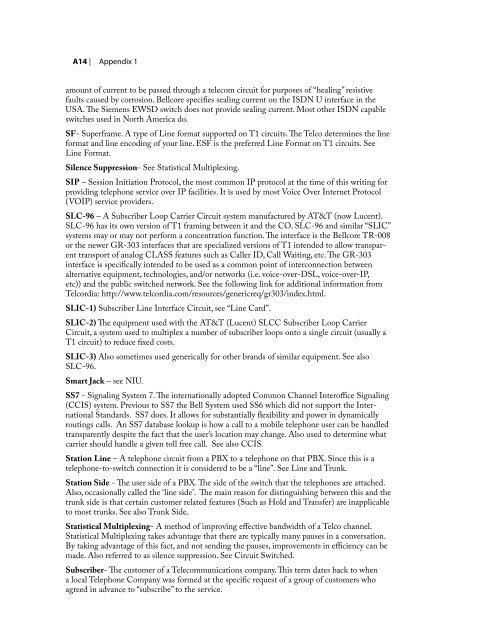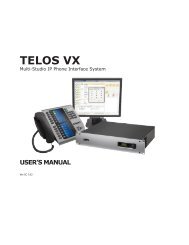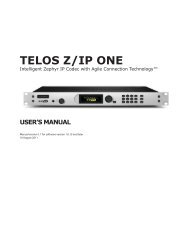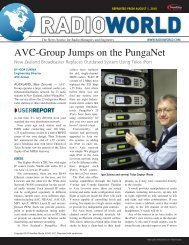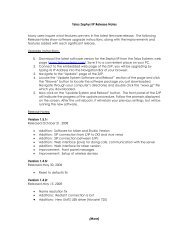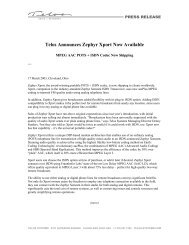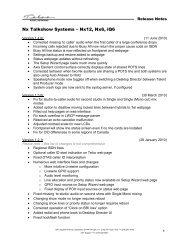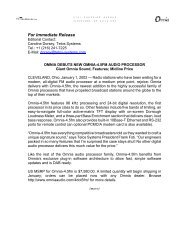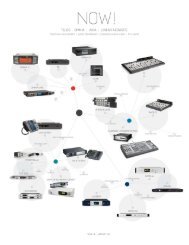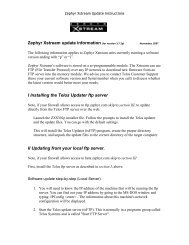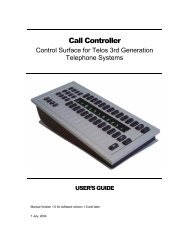Hx1-Hx2 Manual-1.4.1 - Telos
Hx1-Hx2 Manual-1.4.1 - Telos
Hx1-Hx2 Manual-1.4.1 - Telos
Create successful ePaper yourself
Turn your PDF publications into a flip-book with our unique Google optimized e-Paper software.
A14 | appendix 1<br />
amount of current to be passed through a telecom circuit for purposes of “healing” resistive<br />
faults caused by corrosion. Bellcore specifies sealing current on the ISDN U interface in the<br />
USA. The Siemens EWSD switch does not provide sealing current. Most other ISDN capable<br />
switches used in North America do.<br />
SF- Superframe. A type of Line format supported on T1 circuits. The Telco determines the line<br />
format and line encoding of your line. ESF is the preferred Line Format on T1 circuits. See<br />
Line Format.<br />
Silence Suppression- See Statistical Multiplexing.<br />
SIP – Session Initiation Protocol, the most common IP protocol at the time of this writing for<br />
providing telephone service over IP facilities. It is used by most Voice Over Internet Protocol<br />
(VOIP) service providers.<br />
SLC-96 – A Subscriber Loop Carrier Circuit system manufactured by AT&T (now Lucent).<br />
SLC-96 has its own version of T1 framing between it and the CO. SLC-96 and similar “SLIC”<br />
systems may or may not perform a concentration function. The interface is the Bellcore TR-008<br />
or the newer GR-303 interfaces that are specialized versions of T1 intended to allow transparent<br />
transport of analog CLASS features such as Caller ID, Call Waiting, etc. The GR-303<br />
interface is specifically intended to be used as a common point of interconnection between<br />
alternative equipment, technologies, and/or networks (i.e. voice-over-DSL, voice-over-IP,<br />
etc)) and the public switched network. See the following link for additional information from<br />
Telcordia: http://www.telcordia.com/resources/genericreq/gr303/index.html.<br />
SLIC-1) Subscriber Line Interface Circuit, see “Line Card”.<br />
SLIC-2) The equipment used with the AT&T (Lucent) SLCC Subscriber Loop Carrier<br />
Circuit, a system used to multiplex a number of subscriber loops onto a single circuit (usually a<br />
T1 circuit) to reduce fixed costs.<br />
SLIC-3) Also sometimes used generically for other brands of similar equipment. See also<br />
SLC-96.<br />
Smart Jack – see NIU.<br />
SS7 - Signaling System 7. The internationally adopted Common Channel Interoffice Signaling<br />
(CCIS) system. Previous to SS7 the Bell System used SS6 which did not support the International<br />
Standards. SS7 does. It allows for substantially flexibility and power in dynamically<br />
routings calls. An SS7 database lookup is how a call to a mobile telephone user can be handled<br />
transparently despite the fact that the user’s location may change. Also used to determine what<br />
carrier should handle a given toll free call. See also CCIS.<br />
Station Line – A telephone circuit from a PBX to a telephone on that PBX. Since this is a<br />
telephone-to-switch connection it is considered to be a “line”. See Line and Trunk.<br />
Station Side - The user side of a PBX. The side of the switch that the telephones are attached.<br />
Also, occasionally called the ‘line side’. The main reason for distinguishing between this and the<br />
trunk side is that certain customer related features (Such as Hold and Transfer) are inapplicable<br />
to most trunks. See also Trunk Side.<br />
Statistical Multiplexing- A method of improving effective bandwidth of a Telco channel.<br />
Statistical Multiplexing takes advantage that there are typically many pauses in a conversation.<br />
By taking advantage of this fact, and not sending the pauses, improvements in efficiency can be<br />
made. Also referred to as silence suppression. See Circuit Switched.<br />
Subscriber- The customer of a Telecommunications company. This term dates back to when<br />
a local Telephone Company was formed at the specific request of a group of customers who<br />
agreed in advance to “subscribe” to the service.


